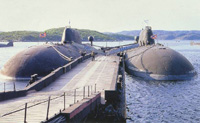Russian Navy was absolutely negligent to withdraw vessels from Baltic republics
The Russian Navy abandoned 22 submarines during removal of the Russian forces from the Baltic republics
Many western museums have Soviet submarines among their exhibits. When perestroika began, Russia started to trade even in things traditionally esteemed as relics. That also concerned the Russian fleet. Russia often sold ships during removal of army bases from former Baltic republics. 
The Navy had to sell vessels because of nonpayment of wages and wishing to keep the core of the fleet. At that, ships were often sold at a cheaper price than scrap metal; Swedish and German ferryboats transported many of Russian ships away from Russia. But still many ships remained deserted waterlogged in bays and harbors. In the army harbor of the Latvian city of Liepaja, the Russian fleet left over 40 battleships and three submarines and a floating dock remained in the harbor of Bolderai in Riga. The neglected vessels were the reason why the authorities of the Baltic countries reproached Russia of “deliberate pollution of the European environment.”
But as it turned out later, Russia had no schemes to cause harm to the Baltic republics at all. In fact, removal of the Russian troops from the Baltic republics revealed absolute chaos and disorganization in the Russian army. Indeed, a thrifty owner would have seized every opportunity to at least dispose of scrap metal. In June 1941, the Soviet Navy abandoned seven submarines in Liepaja when the German troops were advancing. This is incredible that in peaceful conditions of 1994, the Russian Navy abandoned 22 submarines during removal of the Russian forces from the Baltic republics.
In 1941, lieutenant-commander Afanasyev decided to blow up disabled ships so that Germans could not use them, and as a result of the initiative the man was executed by shooting. Was there anyone in the army made responsible for abandoning the Russian squadron in the Baltic republics? In Latvia, the remains of the Baltic Fleet gave birth to a network of companies selling scrap metal. It was approximately at the same period that Estonia also became one of the world leaders in exporting metal.
Click here to see the photo gallery of the Russian Navy in action
People selling Russian vessels abroad did not specify especially for what purpose they must be further used. Often, Russian ships were turned into floating restaurants, bars and even brothels (B-24 was turned into a brothel in Copenhagen). Later, Germans bought the ship to make it a naval museum in Penemuende. Now, after some repairing the vessel is a key exhibit of the exposition. B-77, after it was enabled for shooting K-19: The Widowmaker, became a permanent exhibit of the naval museum in Providence, US. Americans swore they would respect the Russian submarine not less than the key exhibit of the museum, Saratoga aircraft-carrier.
Today, B-77 is not only a museum; it is a teaching complex used for scientific conferences and scout gatherings. Newly married couples often walk along the deck of the Soviet rocket carrier believing it may make their future family life happy.
Captain Sergey Aprelev
Subscribe to Pravda.Ru Telegram channel, Facebook, RSS!





